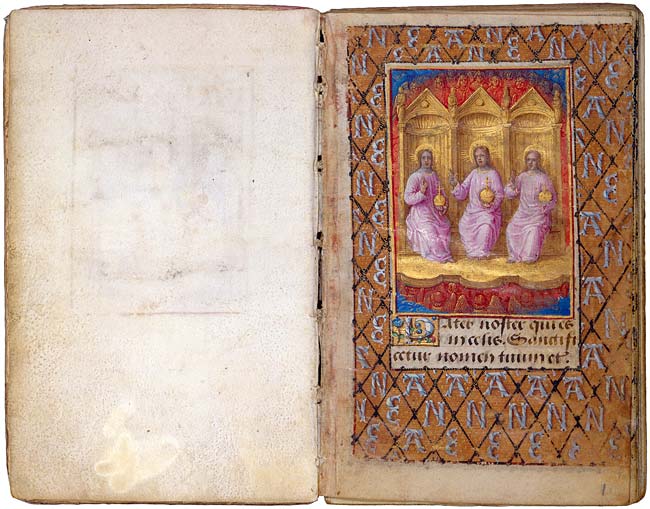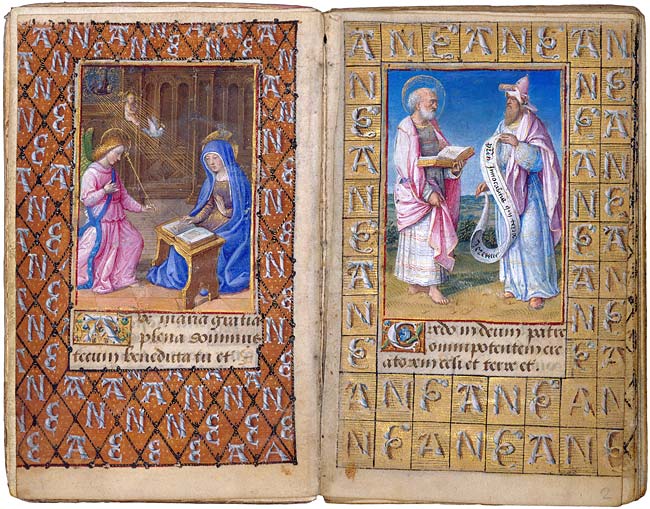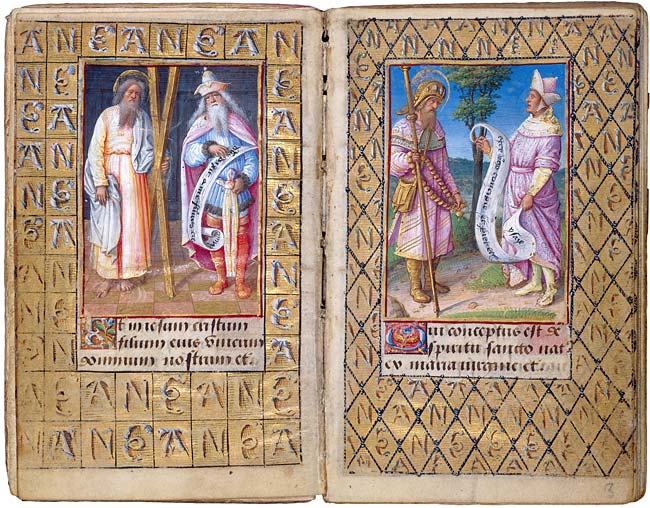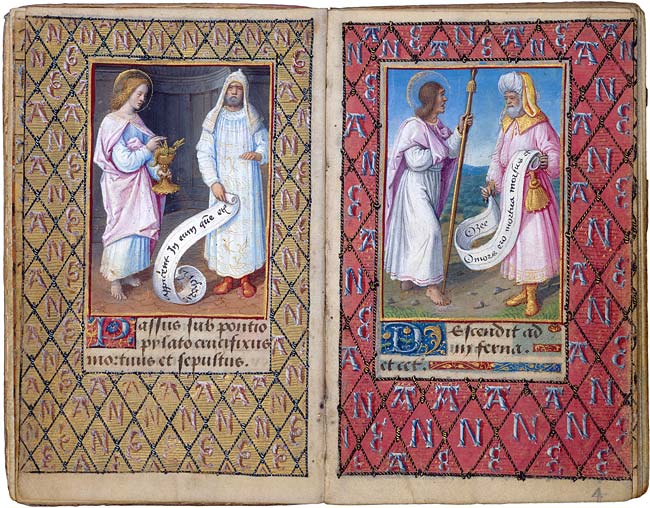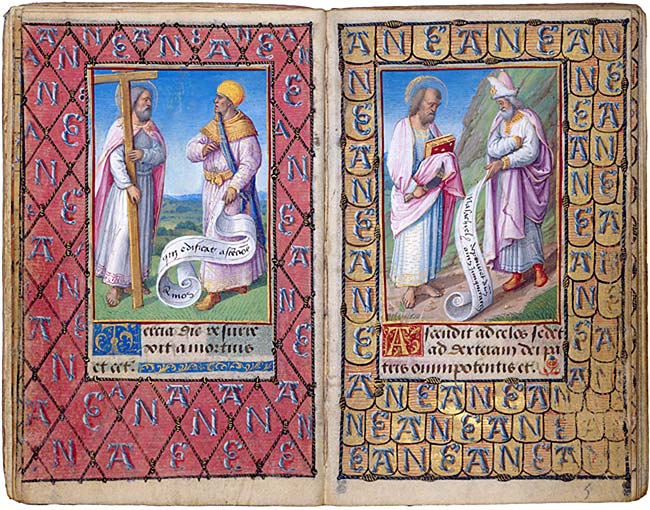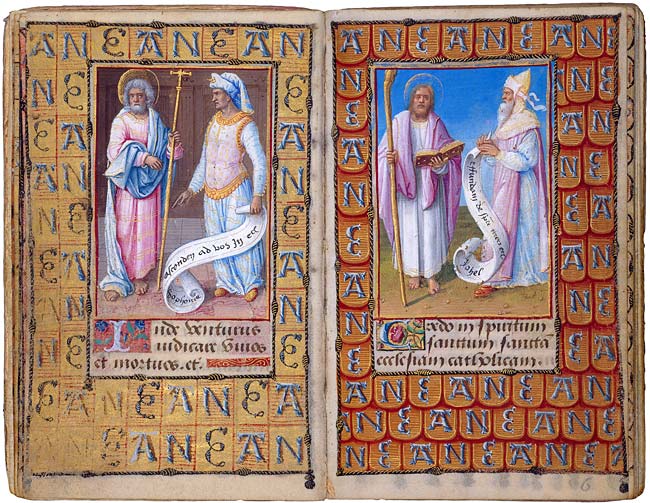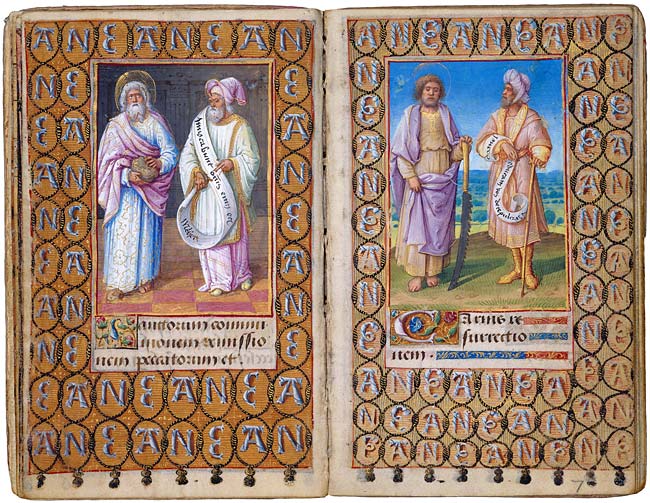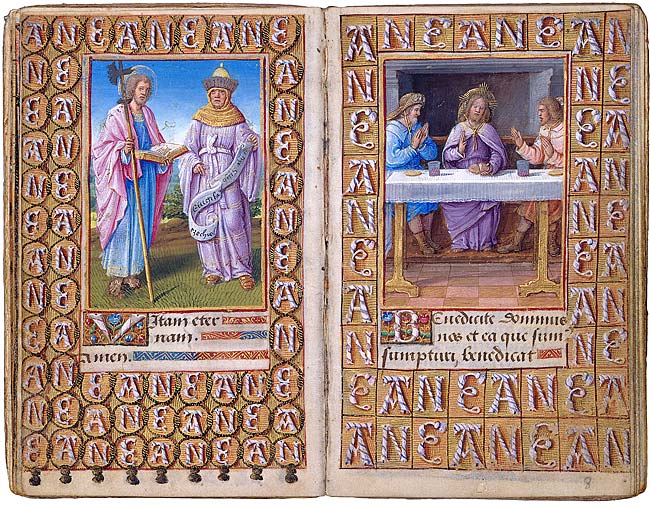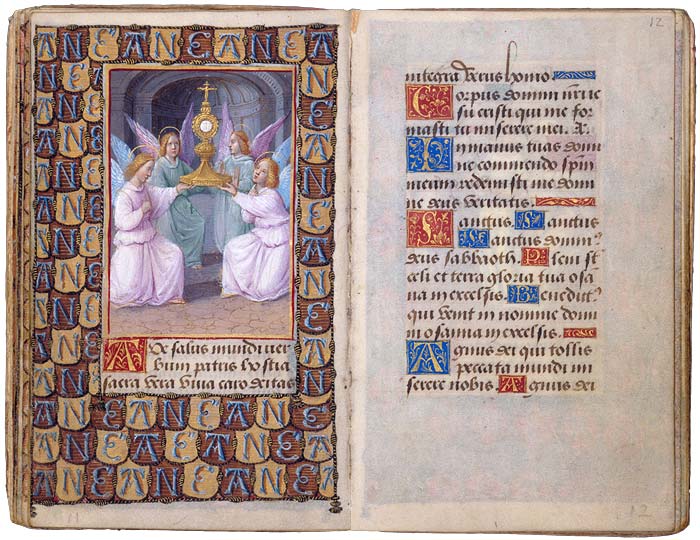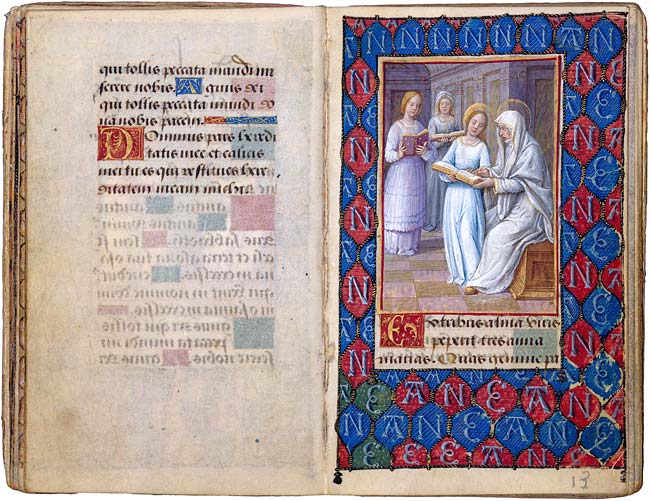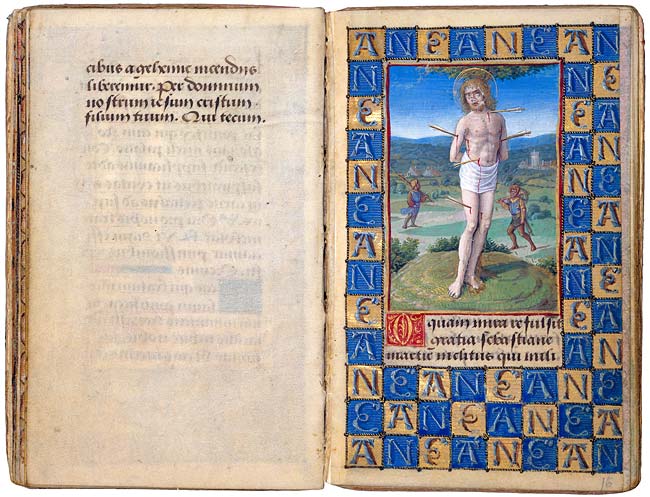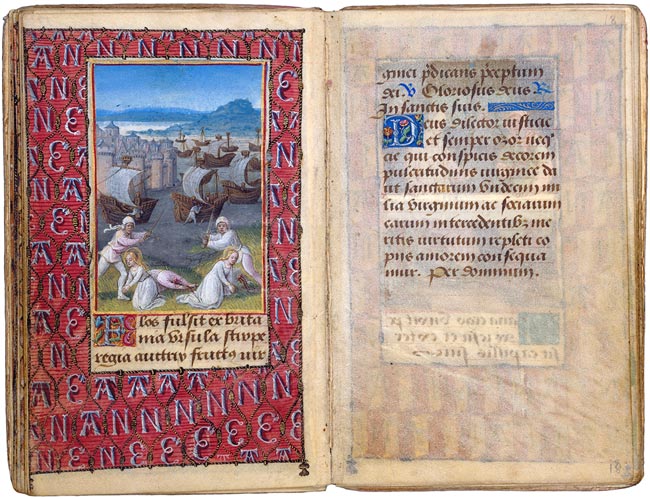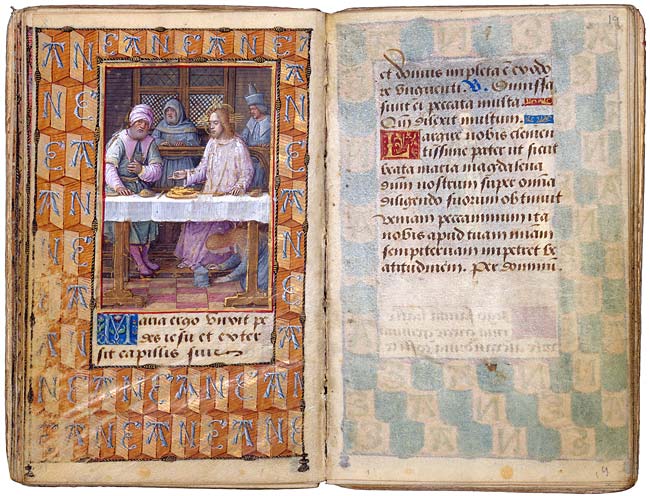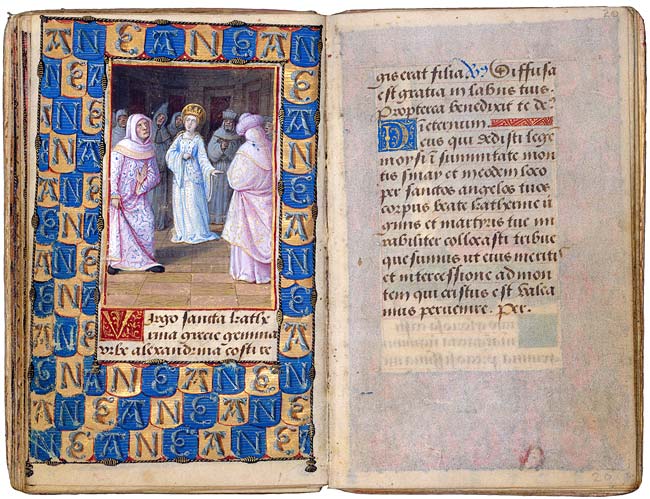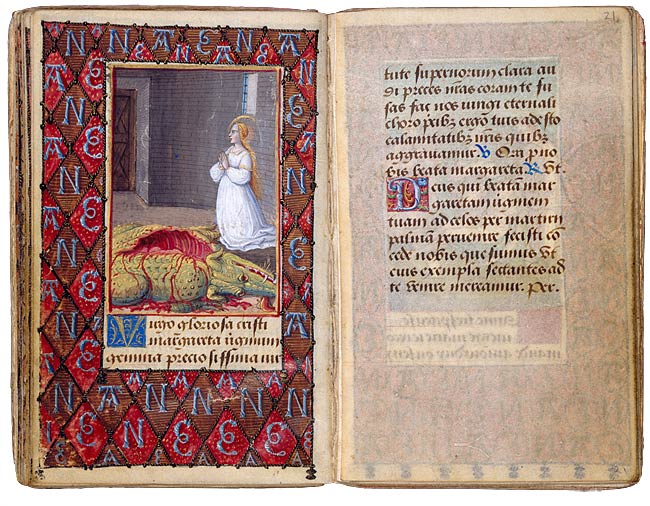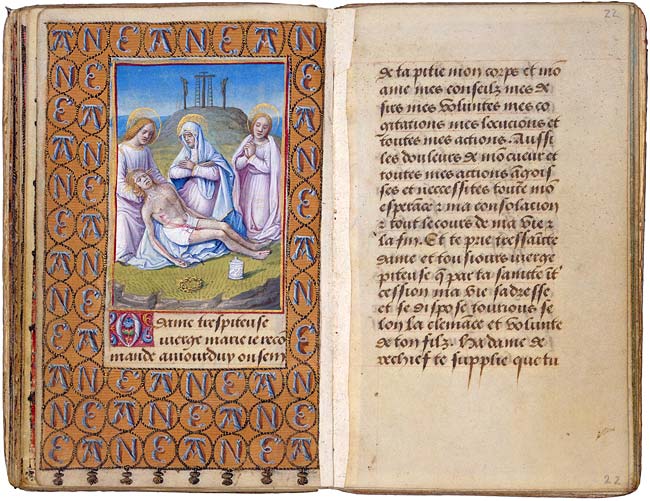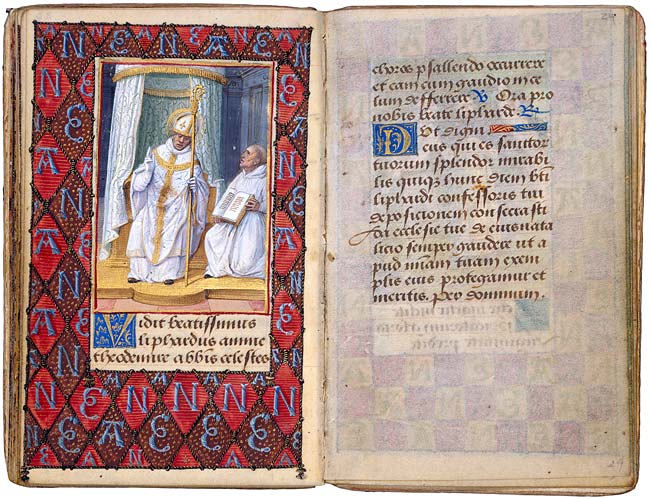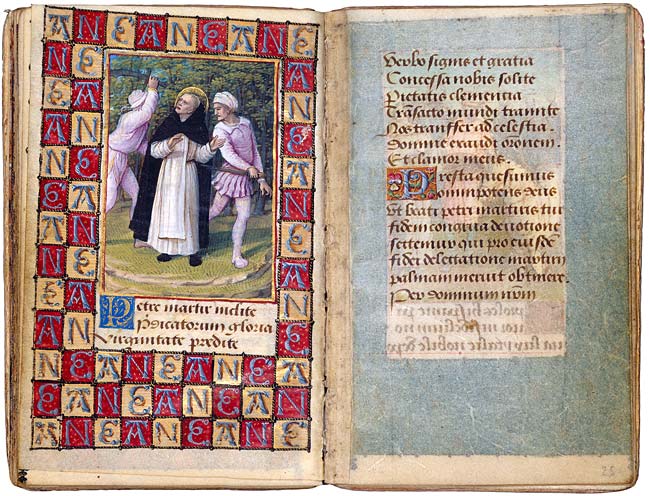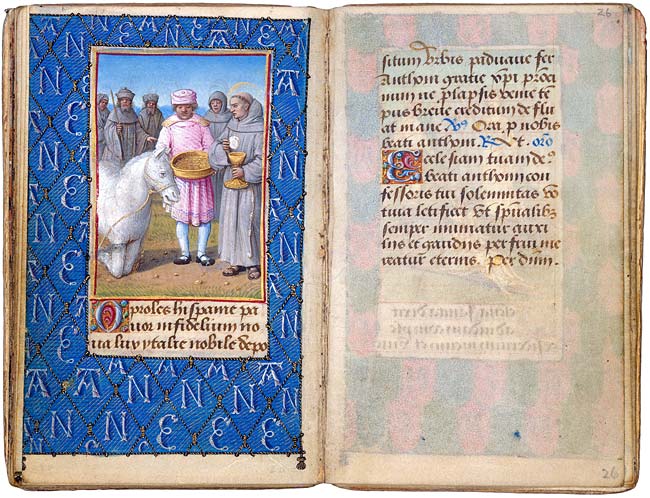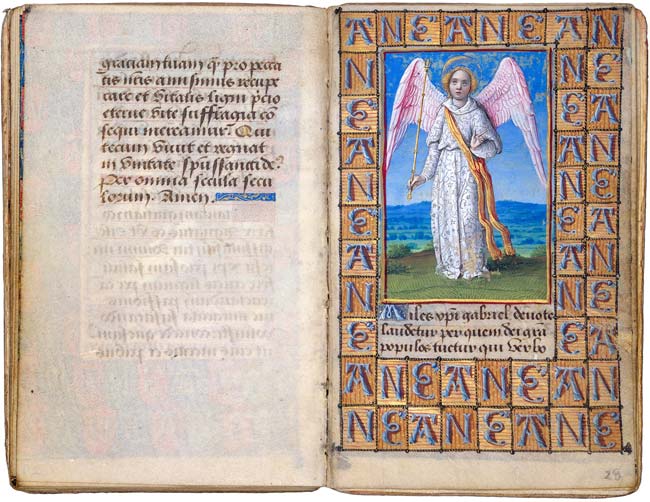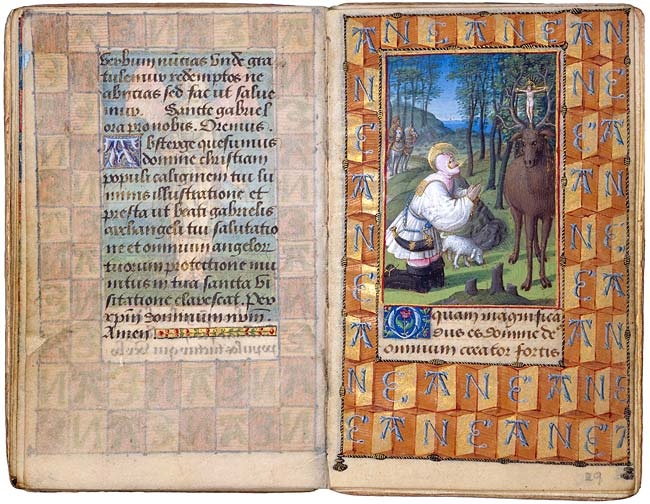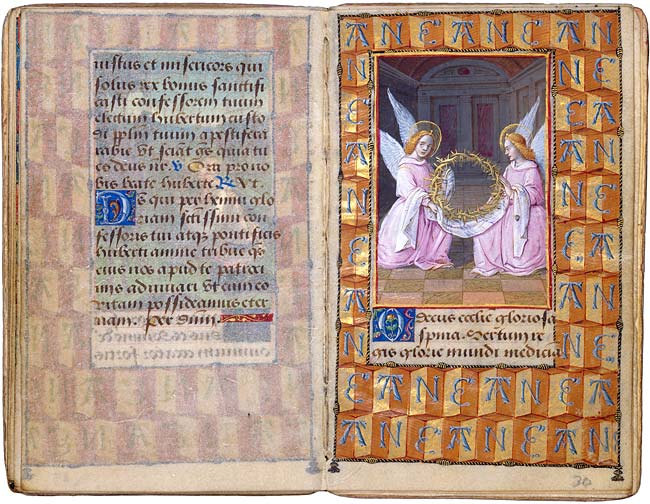Prayer Book of Anne de Bretagne
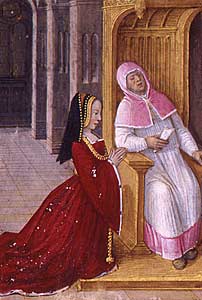 This prayer book was commissioned by Anne de Bretagne, wife of two successive kings of France, Charles VIII and Louis XII, to teach her son, the dauphin Charles-Orland (1492–1495), his catechism. It was painted in Tours by Jean Poyer, an artist documented as working for the queen. The book is richly illustrated, and its thirty-four airy, light-flooded miniatures are among the most delicate examples of late-fifteenth-century art.
This prayer book was commissioned by Anne de Bretagne, wife of two successive kings of France, Charles VIII and Louis XII, to teach her son, the dauphin Charles-Orland (1492–1495), his catechism. It was painted in Tours by Jean Poyer, an artist documented as working for the queen. The book is richly illustrated, and its thirty-four airy, light-flooded miniatures are among the most delicate examples of late-fifteenth-century art.
Also by Jean Poyer: The Hours of Henry VIII »
Anne de Bretagne at Confession
Prayer Book of Anne de Bretagne
Illuminated by Jean Poyer
France, Tours, ca. 1492–95
126 x 80 mm
The Pierpont Morgan Library, Purchased in 1905; MS M.50 (fol. 10v)
Thumbnails
Fol. 1
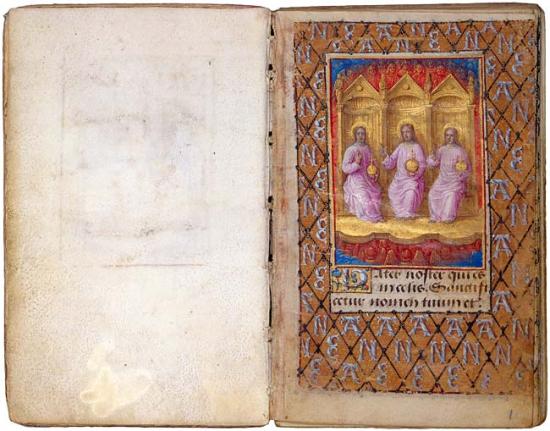
Trinity
Prayer Book of Anne de Bretagne
Illuminated by Jean Poyer
The Pierpont Morgan Library, Purchased in 1905
This prayer book was commissioned by Anne de Bretagne, wife of two successive kings of France, Charles VIII and Louis XII, to teach her son, the dauphin Charles-Orland (1492–1495), his catechism. It was painted in Tours by Jean Poyer, an artist documented as working for the queen. The book is richly illustrated, and its thirty-four airy, light-flooded miniatures are among the most delicate examples of late-fifteenth-century art.
Poyer begins the Prayer Book of Anne de Bretagne with an image of the Three Persons of the Holy Trinity, which is a fundamental doctrine of Christianity. The picture illustrates the Our Father.
Poyer's Trinity is unusual. Instead of differentiating among the Three Persons: Father, Son, and Holy Spirit, he represents each as a young man with long hair.
Each figure of Poyer's Trinity holds an orb adorned with a cross, signifying Christ's salvation of the world.
Fol. 1v-2
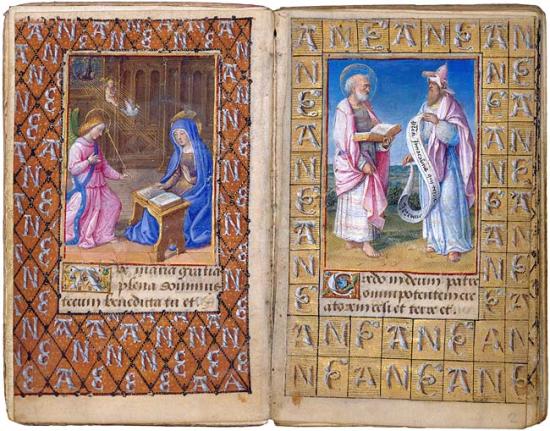
Annunciation
The Apostle Peter and the Prophet Jeremiah
Prayer Book of Anne de Bretagne
Illuminated by Jean Poyer
The Pierpont Morgan Library, Purchased in 1905
This prayer book was commissioned by Anne de Bretagne, wife of two successive kings of France, Charles VIII and Louis XII, to teach her son, the dauphin Charles-Orland (1492–1495), his catechism. It was painted in Tours by Jean Poyer, an artist documented as working for the queen. The book is richly illustrated, and its thirty-four airy, light-flooded miniatures are among the most delicate examples of late-fifteenth-century art.
Annunciation (fol. 1v, left)
The Virgin Mary, surprised at her prayers, raises her eyes at Gabriel's announcement that she has been chosen to be the Mother of God. The miniature accompanies the Hail Mary.
The Virgin, who is depicted praying, serves as a pious visual model for Anne de Bretagne who, herself a mother, commissioned the Prayer Book.
Poyer depicts God the Father, holding an orb, sending forth the Christ Child, who bearing a Cross, follows the Holy Spirit in the form of a dove, along golden rays toward his future mother. Beginning in the fourteenth century, artists employed this iconography to indicate the involvement of all Three Persons of the Trinity in the miracle of the Incarnation.
Et is a Latin abbreviation for etcetera, meaning "and the rest." The text of the Hail Mary is actually incomplete: there was insufficient space on the page to write the whole prayer, and, in any case, Anne de Bretagne knew the words by heart.
The Apostle Peter and the Prophet Jeremiah (fol. 2, right)
Peter and Jeremiah begin a series of twelve illuminations pairing an Apostle, identified with a halo and an attribute, with a prophet of the Old Testament holding a scroll.
Poyer followed artistic and theological tradition by depicting Peter, the "Prince of the Apostles" and the "rock" (from the Greek word Petros) upon which Christ built the Church, first among his series of Apostles.
The Apostles' Creed, the prayer that accompanies the following series oftwelve miniatures, along with the Our Father and Hail Mary that begin the book, were rarely found in medieval and Renaissance prayer books because every Christian knew them by heart. Their presence here indicates that this book was made for a child.
Fol. 2v-3
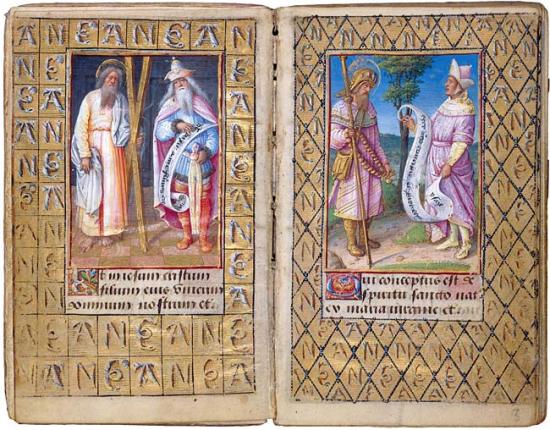
The Apostle Andrew and the Prophet David
The Apostle James the Major and the Prophet Isaiah
Prayer Book of Anne de Bretagne
Illuminated by Jean Poyer
The Pierpont Morgan Library, Purchased in 1905
This prayer book was commissioned by Anne de Bretagne, wife of two successive kings of France, Charles VIII and Louis XII, to teach her son, the dauphin Charles-Orland (1492–1495), his catechism. It was painted in Tours by Jean Poyer, an artist documented as working for the queen. The book is richly illustrated, and its thirty-four airy, light-flooded miniatures are among the most delicate examples of late-fifteenth-century art.
The Apostle Andrew and the Prophet David (fol. 2v, left)
Andrew, the "first called" by Christ, holds the cross upon which he was martyred. David, like all the prophets, holds a scroll inscribed with words thought to prefigure Christian beliefs. His scroll quotes Psalm 2:7, D(omi)n(u)s dixit a(d) me filius (The Lord hath said to me: thou art my son).
As attributes identify the saints, exotic costume distinguishes the prophets as belonging to the Old Testament. King David's particularly foppish dress probably alludes to his sinful past.
Attributes (such as Andrew's distinctive X-shaped cross) were devices commonly used by medieval, Renaissance, and baroque artists to identify a saint.
The Apostle James the Major and the Prophet Isaiah (fol. 3, right)
St. James wears the outfit of a medieval pilgrim: tall staff, traveling satchel, rosary, and cockleshell hat. Opposite him stands Isaiah, unfurling his scroll. As in many of the miniatures, apostle and prophet are depicted as if in theological debate or pensive conversation.
James is attired as a pilgrim because his burial site, Santiago de Compostela in Spain, was the most popular of all medieval pilgrimage shrines.
The Apostles' Creed, the third prayer in Anne's Prayer Book, is not written in continuous text but is divided into the Twelve Articles of Faith, one per page.
Fol. 3v-4
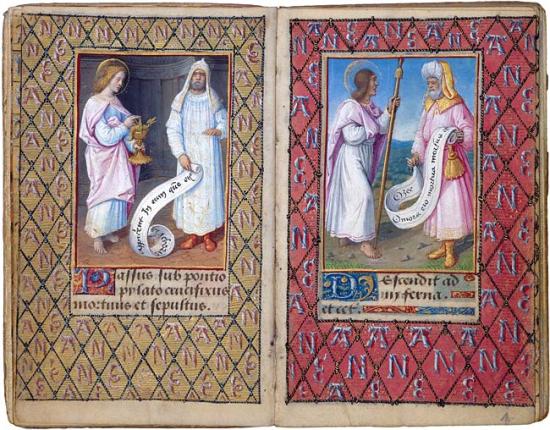
The Apostle John and the Prophet Zachariah
The Apostle Thomas and the Prophet Hosea
Prayer Book of Anne de Bretagne
Illuminated by Jean Poyer
The Pierpont Morgan Library, Purchased in 1905
Poyer's penultimate image offers an immediate and intimate encounter with a powerful symbol of Christ's Passion.
Anne de Bretagne was particularly devoted to the Crown of Thorns. King Louis IX of France had acquired the Crown of Thorns in 1239; he built the Ste.-Chapelle as a suitable church in which to house it and other relics. Anne de Bretagne, as queen, had particular and private access to the chapelle and its precious contents.
The Apostle John and the Prophet Zachariah (fol. 3v, left)
Poyer employed subtle and dramatic juxtapositions. Here he contrasts the typical colors of his light palette—the pale pinks and blues of the clothing of John and Zachariah —the dark chiaroscuro of the interior behind them.
John's gold cup containing a serpent alludes to the attempt on his life by the high priest Aristodemus, who challenged the Apostle to drink a draught of poison. John's miraculous imbibing of the deadly liquid with no ill effect converted the priest.
The Apostle Thomas and the Prophet Hosea (fol. 4, right)
Thomas, holding the lance of his martyrdom, is shown in active conversation with Hosea, whose response is written on his scroll, O mors ero mor(s) tua morsus (O death, I will be thy death).
The active communication between the two figures is a visualization of the link between the Old and New Testaments, between the Articles of the Apostles' Creed and the declarations of the prophets. The pairing of Apostles and prophets in Anne's manuscript draws on a tradition dating back to the early fourteenth century.
Fol. 4v-5
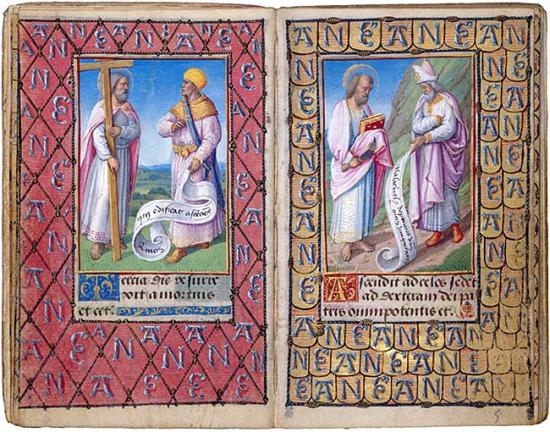
The Apostle Philip and the Prophet Amos
The Apostle Bartholomew and the Prophet Malachi
Prayer Book of Anne de Bretagne
Illuminated by Jean Poyer
The Pierpont Morgan Library, Purchased in 1905
This prayer book was commissioned by Anne de Bretagne, wife of two successive kings of France, Charles VIII and Louis XII, to teach her son, the dauphin Charles-Orland (1492–1495), his catechism. It was painted in Tours by Jean Poyer, an artist documented as working for the queen. The book is richly illustrated, and its thirty-four airy, light-flooded miniatures are among the most delicate examples of late-fifteenth-century art.
The Apostle Philip and the Prophet Amos (fol. 4v, left)
Holding the tau T-shaped cross upon which he was bound and stoned to death and with which he revived a dead boy, Philip encounters Amos above the sixth Article of Faith from the Apostles' Creed, which appropriately discusses Christ's resurrection.
The same cross that Poyer depicts as Philip's attribute also refers to the one by which Philip banished a serpent that people were worshiping in Scythia, where the Apostle had brought the Gospel. The angry priests of the serpents martyred Philip upon that cross.
The Apostle Bartholomew and the Prophet Malachi (fol. 5, right)
While looking at the book of the New Testament in Bartholomew's hand, Malachi unfurls a scroll as the figures appear to contemplate each other's words.
The curved knife in Bartholomew's hand refers to the instrument used by barbarians in India and Greater Armenia— where the Apostle preached the Gospel—to slice and remove his skin.
Fol. 5v-6
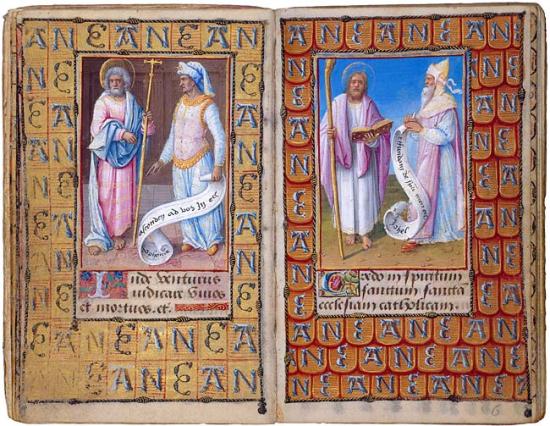
The Apostle Simon and the Prophet Sophonias
The Apostle James the Minor and the Prophet Joel
Prayer Book of Anne de Bretagne
Illuminated by Jean Poyer
The Pierpont Morgan Library, Purchased in 1905
This prayer book was commissioned by Anne de Bretagne, wife of two successive kings of France, Charles VIII and Louis XII, to teach her son, the dauphin Charles-Orland (1492–1495), his catechism. It was painted in Tours by Jean Poyer, an artist documented as working for the queen. The book is richly illustrated, and its thirty-four airy, light-flooded miniatures are among the most delicate examples of late-fifteenth-century art.
The Apostle Simon and the Prophet Sophonias (fol. 5v, left)
Poyer skillfully depicts Simon and Sophonias in a subtly dramatic moment, in which the prophet sternly gestures to the cautious Apostle.
Sophonias's scroll is appropriate for his serious demeanor and gesture of warning. Inscribed "I will come to you in judgement," the words prophesize Christ's judgment of humankind on the Last Day, also the theme of the accompanying Article of Faith. The scroll attributes the text to Sophonias, when it was actually written by the prophet Malachi; this is one of many such mistakes of textual attribution.
The Apostle James the Minor and the Prophet Joel (fol. 6, right)
James, the first bishop of Jerusalem, stands with the club with which he was beaten to death, and a book of the New Testament in a barren landscape with the prophet Joel.
James was clubbed to death with a fuller's bat (a club used to full, or cleanse, cloth by beating) after he was thrown from the parapet of the Temple in Jerusalem. He was perceived as a threat becausehe had converted so many Jews to Christianity.
The bound book that James (like Peter, Bartholomew, and Matthias) holds contrasts with Joel's scroll. In medieval and Renaissance art, roll and codex often represent the Jewish Old Testament and the Christian New Law.
Fol. 6v-7
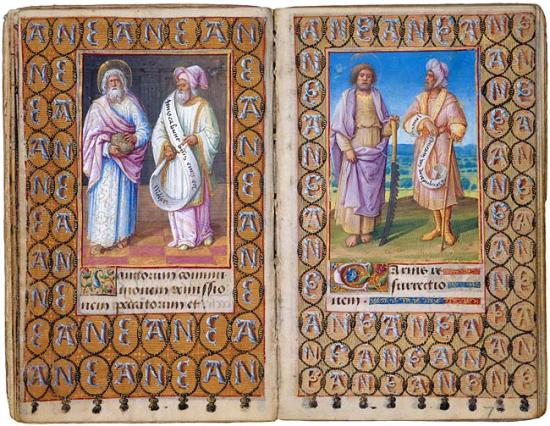
The Apostle Matthew and the Prophet Micah
The Apostle Jude and the Prophet Daniel
Prayer Book of Anne de Bretagne
Illuminated by Jean Poyer
The Pierpont Morgan Library, Purchased in 1905
This prayer book was commissioned by Anne de Bretagne, wife of two successive kings of France, Charles VIII and Louis XII, to teach her son, the dauphin Charles-Orland (1492–1495), his catechism. It was painted in Tours by Jean Poyer, an artist documented as working for the queen. The book is richly illustrated, and its thirty-four airy, light-flooded miniatures are among the most delicate examples of late-fifteenth-century art.
The Apostle Matthew and the Prophet Micah (fol. 6v, left)
Poyer was a master of perspective, a talent praised even in his own time. The receding floor tiles, as well as the shadows cast by Matthew and Micah, simply but convincingly describe the depth of the room.
Before being called by Christ, Matthew was a tax collector for the Romans (an occupation particularly despised by his fellow Jews). His attribute is a bag of money.
The Apostle Jude and the Prophet Daniel (fol. 7, right)
Jude and Daniel stand in a beautiful landscape, rendered convincingly vast through Poyer's use of aerial or atmospheric perspective, in which the features become blurred and the colors cooler as the landscape recedes.
Jude holds the long saw by which he was purportedly cut in two.
Fol. 7v-8
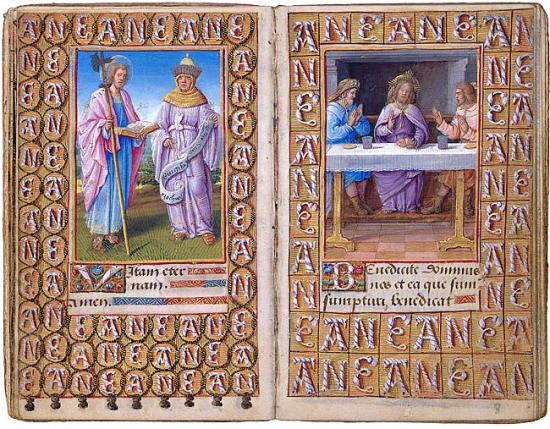
The Apostle Matthias and the Prophet Ezekiel
The Supper at Emmaus
Prayer Book of Anne de Bretagne
Illuminated by Jean Poyer
The Pierpont Morgan Library, Purchased in 1905
This prayer book was commissioned by Anne de Bretagne, wife of two successive kings of France, Charles VIII and Louis XII, to teach her son, the dauphin Charles-Orland (1492–1495), his catechism. It was painted in Tours by Jean Poyer, an artist documented as working for the queen. The book is richly illustrated, and its thirty-four airy, light-flooded miniatures are among the most delicate examples of late-fifteenth-century art.
The Apostle Matthias and the Prophet Ezekiel (fol. 7v, left)
Matthias reads from an open copy of the New Testament; Ezekiel points to the words on his scroll, Evigila(bunt) om(ne)s ali (All shall awake, others . . . ).
Matthias is always last among the Apostles because he was chosen from the seventy-two disciples to restore to twelve the number of the Apostles after Judas's betrayal and suicide.
Poyer employs the letters A, N, and E in regular patterns surrounding all the miniatures; the letters spell the first name of the patron, Anne de Bretagne.
The letters of the border are enmeshed within interlacing strands of the cordelière, a personal device of Anne's referring to the cords St. Francis of Assisi wrapped around his torso to remind him of those that had bound Christ.
The Supper at Emmaus (fol. 8, right)
The two disciples with Christ raise their hands in pious surprise and awe as they recognize their newly resurrected Savior after he has blessed, broken, and shared bread with them in the village of Emmaus.
Poyer's rendering of a prayerful moment before eating, a subject often painted on walls of monastic refectories in the Middle Ages and Renaissance, illustrates the prayer Grace before Meals accompanying this miniature.
The three figures wear pilgrim hats (although Christ and the disciple at the right have thrown theirs back on their shoulders) like that worn by the Apostle James the Major.
Fol. 9
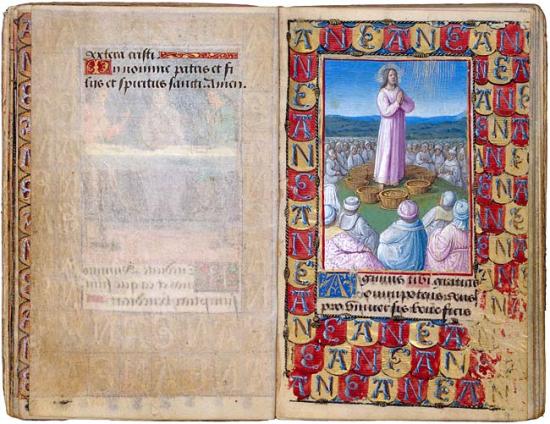
The Multiplication of the Loaves and Fishes
Prayer Book of Anne de Bretagne
Illuminated by Jean Poyer
This prayer book was commissioned by Anne de Bretagne, wife of two successive kings of France, Charles VIII and Louis XII, to teach her son, the dauphin Charles-Orland (1492–1495), his catechism. It was painted in Tours by Jean Poyer, an artist documented as working for the queen. The book is richly illustrated, and its thirty-four airy, light-flooded miniatures are among the most delicate examples of late-fifteenth-century art.
The Multiplication of the Loaves and Fishes (fol. 9, right)
Christ, surrounded by the baskets containing remnants of miraculous food, raises his hands in prayer and his eyes toward heavenly rays. He thus gives thanks after the miracle has occurred and the food eaten; the miniature is a fitting illustration accompanying the prayer Grace after Meals.
Poyer shows the backs of the figures gathered around Christ, a device invented by the fourteenth-century Italian artist Giotto and embraced by Renaissance artists to indicate the three-dimensionality of the people and the vastness of the space they occupy.
Fol. 10v
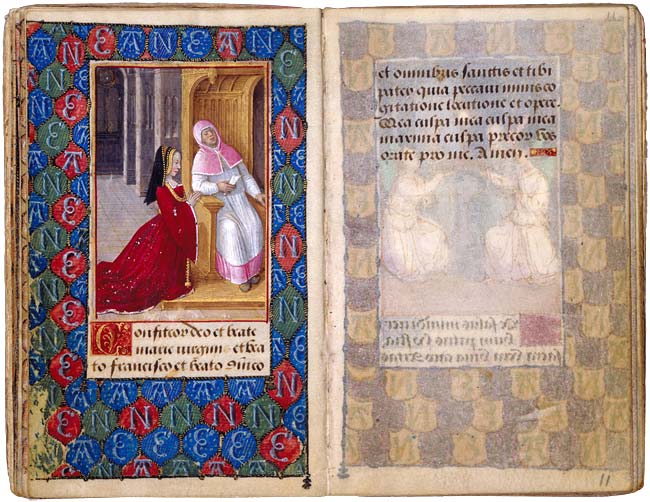
Anne de Bretagne at Confession
Prayer Book of Anne de Bretagne
Illuminated by Jean Poyer
The Pierpont Morgan Library, Purchased in 1905
This prayer book was commissioned by Anne de Bretagne, wife of two successive kings of France, Charles VIII and Louis XII, to teach her son, the dauphin Charles-Orland (1492–1495), his catechism. It was painted in Tours by Jean Poyer, an artist documented as working for the queen. The book is richly illustrated, and its thirty-four airy, light-flooded miniatures are among the most delicate examples of late-fifteenth-century art.
Anne de Bretagne at Confession (fol. 10v, left)
Anne is shown at confession, kneeling, not in a wooden enclosure but beside her confessor, who leans toward her to hear her whispered sins. The miniature illustrates the Act of Confession.
Private devotional books were often personalized with portraits of the individual who commissioned them. The fact that Anne is shown as a sinner indicates that she personally commissioned this book, for no one would have dared to give the queen a book that represented her in this way.
Poyer paints Anne wearing the Breton cap, which signified her ties to her homeland of Brittany, and dress in maroon, a favorite color of the queen.
Fol. 11v
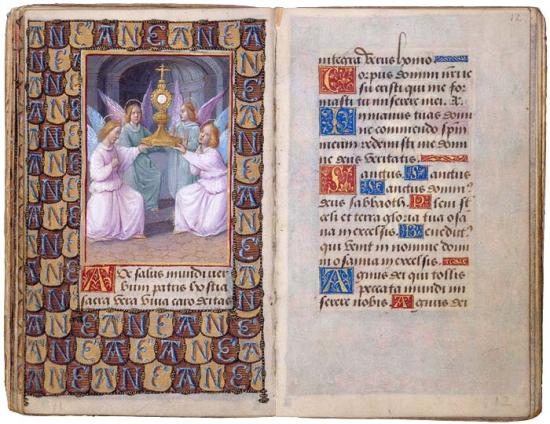
Angels Displaying the Eucharist in a Monstrance
Prayer Book of Anne de Bretagne
Illuminated by Jean Poyer
The Pierpont Morgan Library, Purchased in 1905
This prayer book was commissioned by Anne de Bretagne, wife of two successive kings of France, Charles VIII and Louis XII, to teach her son, the dauphin Charles-Orland (1492–1495), his catechism. It was painted in Tours by Jean Poyer, an artist documented as working for the queen. The book is richly illustrated, and its thirty-four airy, light-flooded miniatures are among the most delicate examples of late-fifteenth-century art.
Angels Displaying the Eucharist in a Monstrance (fol. 11v, left)
On bended knees, two angels elevate a monstrance in which is displayed the consecrated Host, or wafer, which is stamped withan image of the Crucifixion. Behind them, two more angels raise their hands in awe.
Beginning in the late Middle Ages, gazing upon the Host, understood to contain, in transubstantiated form, Christ's body, was considered to be as spiritually effective as receiving it in communion. The miniature accompanies a prayer said at Mass during the Elevation of the Host.
A monstrance is a vessel in which the consecrated Host is displayed for the adoration of the faithful.
Fol. 13
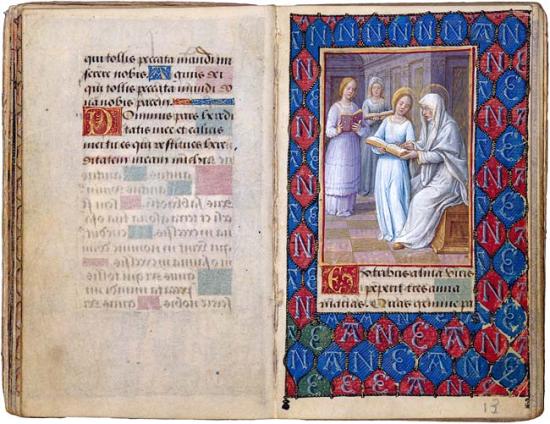
St. Anne Instructing the Virgin
Prayer Book of Anne de Bretagne
Illuminated by Jean Poyer
The Pierpont Morgan Library, Purchased in 1905
This prayer book was commissioned by Anne de Bretagne, wife of two successive kings of France, Charles VIII and Louis XII, to teach her son, the dauphin Charles-Orland (1492–1495), his catechism. It was painted in Tours by Jean Poyer, an artist documented as working for the queen. The book is richly illustrated, and its thirty-four airy, light-flooded miniatures are among the most delicate examples of late-fifteenth-century art.
St. Anne Instructing the Virgin (fol. 13, right)
St. Anne points to a place in the book held by her daughter, the young Virgin Mary, while Anne's other daughters eagerly await instruction in the background.
Anne de Bretagne's attachment to her patron and namesake is reflected in the priority she gives to the saint in the sequence of fourteen Suffrages, or prayers dedicated to saints, of which St. Anne's is the first.
The saint's pedagogical role mirrored Anne's intention to use this book as an instructional manual for her young son, Charles-Orland.
Poyer portrays St. Anne in the Hours of Henry VIII.
Fol. 14v
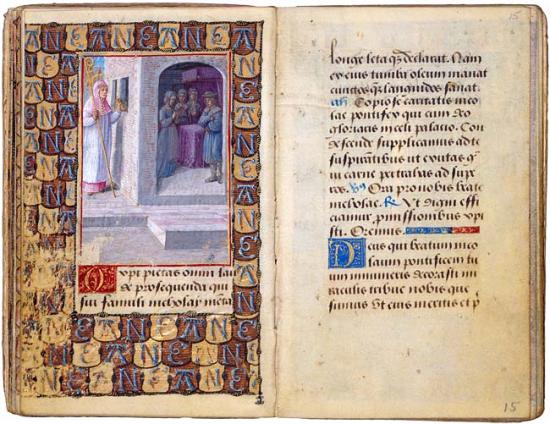
St. Nicholas Delivering the Dowry to the Three Poor Maidens
Prayer Book of Anne de Bretagne
Illuminated by Jean Poyer
The Pierpont Morgan Library, Purchased in 1905
This prayer book was commissioned by Anne de Bretagne, wife of two successive kings of France, Charles VIII and Louis XII, to teach her son, the dauphin Charles-Orland (1492–1495), his catechism. It was painted in Tours by Jean Poyer, an artist documented as working for the queen. The book is richly illustrated, and its thirty-four airy, light-flooded miniatures are among the most delicate examples of late-fifteenth-century art.
St. Nicholas Delivering the Dowry to the Three Poor Maidens (fol. 14v, left)
Nicholas, who inherited wealth from his parents, secretly delivers bags of gold to an impoverished nobleman to provide marriage dowries for his three daughters, so they may find husbands.
Without a dowry (the money or other valuable gift that a woman brings to her husband in marriage), these poor women would have been forced into prostitution. Nicholas piously saved them from such a sinful fate.
Fol. 16
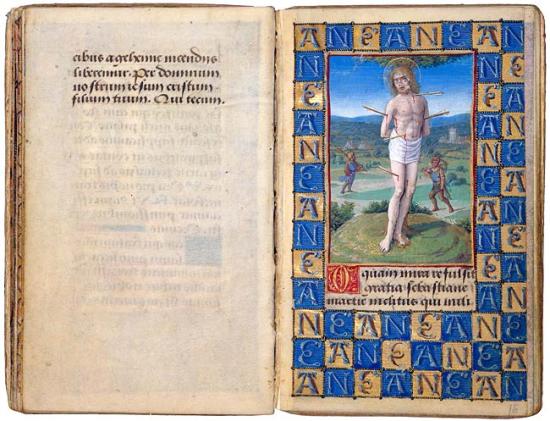
St. Sebastian Shot with Arrows
Prayer Book of Anne de Bretagne
Illuminated by Jean Poyer
The Pierpont Morgan Library, Purchased in 1905
This prayer book was commissioned by Anne de Bretagne, wife of two successive kings of France, Charles VIII and Louis XII, to teach her son, the dauphin Charles-Orland (1492–1495), his catechism. It was painted in Tours by Jean Poyer, an artist documented as working for the queen. The book is richly illustrated, and its thirty-four airy, light-flooded miniatures are among the most delicate examples of late-fifteenth-century art.
St. Sebastian Shot with Arrows (fol. 16, right)
Traditional iconography depicts Sebastian tied to a tree, shot with arrows, and left for dead by the archers. Sebastian was popular in the late Middle Ages and Renaissance because he protected people from bubonic plague, a disease without cure that was widespread in Europe from the fourteenth to the seventeenth century.
Sebastian did not actually die from these arrows; St. Irene removed the weapons and nursed him back to health. Sebastian returned to work for Emperor Diocletian, who promptly had him clubbed to death and thrown into the sewers of Rome.
Fol. 17v
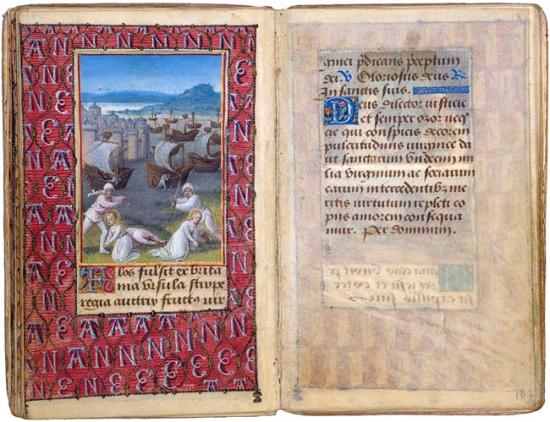
Martyrdom of St. Ursula and Her Companions
Prayer Book of Anne de Bretagne
Illuminated by Jean Poyer
The Pierpont Morgan Library, Purchased in 1905
This prayer book was commissioned by Anne de Bretagne, wife of two successive kings of France, Charles VIII and Louis XII, to teach her son, the dauphin Charles-Orland (1492–1495), his catechism. It was painted in Tours by Jean Poyer, an artist documented as working for the queen. The book is richly illustrated, and its thirty-four airy, light-flooded miniatures are among the most delicate examples of late-fifteenth-century art.
Martyrdom of St. Ursula and Her Companions (fol. 17v, left)
Eleven ships sail the Rhine River as the flotilla of Ursula and her eleven thousand companions arrive at Cologne, Germany. Ursula's refusal to marry the Huns' leader caused him to slaughter the whole group.
Poyer shows the decapitation of three maidens in the foreground; the martyrdom of the rest of Ursula's eleven thousand companions is suggested by further carnage in the background. Ursula was a particular favorite saint of Anne de Bretagne's because, according to tradition, she was one of the earliest queens of Brittany, Anne's homeland.
Fol. 18v
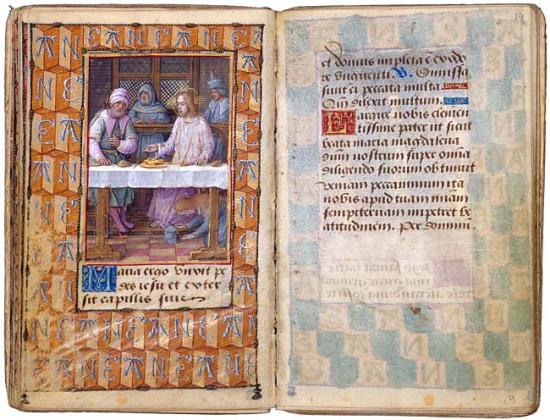
St. Mary Magdalene Washing the Feet of Christ
Prayer Book of Anne de Bretagne
Illuminated by Jean Poyer
The Pierpont Morgan Library, Purchased in 1905
This prayer book was commissioned by Anne de Bretagne, wife of two successive kings of France, Charles VIII and Louis XII, to teach her son, the dauphin Charles-Orland (1492–1495), his catechism. It was painted in Tours by Jean Poyer, an artist documented as working for the queen. The book is richly illustrated, and its thirty-four airy, light-flooded miniatures are among the most delicate examples of late-fifteenth-century art.
St. Mary Magdalene Washing the Feet of Christ (fol. 18v, left)
Mary Magdalene, a former prostitute, kneels under Simon the Pharisee's table. She washes Christ's feet with her tears, dries them with her hair, then kisses and anoints them.
Christ is the dominant figure in this miniature, even though it illustrates the Suffrage to the Magdalene. Her characteristic humility, made famous by her dramatic gesture, is intensified by Poyer's placing her, almost inconspicuously, within the shadows beneath the table, her face nearly hidden.
Poyer portrays St. Mary Magdalene in the Hours of Henry VIII.
Fol. 19v
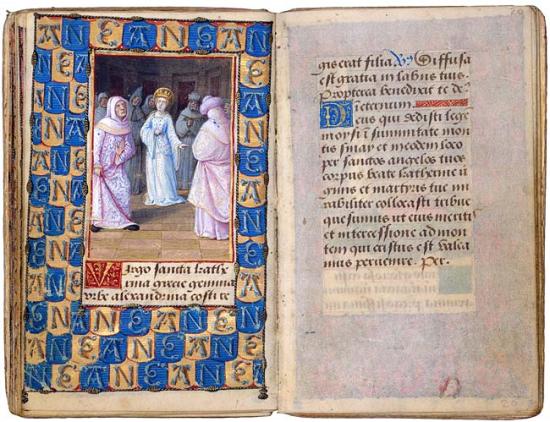
St. Catherine Confounding the Doctors
Prayer Book of Anne de Bretagne
Illuminated by Jean Poyer
The Pierpont Morgan Library, Purchased in 1905
This prayer book was commissioned by Anne de Bretagne, wife of two successive kings of France, Charles VIII and Louis XII, to teach her son, the dauphin Charles-Orland (1492–1495), his catechism. It was painted in Tours by Jean Poyer, an artist documented as working for the queen. The book is richly illustrated, and its thirty-four airy, light-flooded miniatures are among the most delicate examples of late-fifteenth-century art.
St. Catherine Confounding the Doctors (fol. 19v, left)
St. Catherine of Alexandria, the patron saint of learning and education, is shown using her wisdom to convert to Christianity fifty philosophers who were summoned to convince the saint of the error of her Christian ways.
Catherine is usually depicted with the instrument of her martyrdom, a spiked wheel on which she was to be stretched and torn. Poyer's unusual de- piction emphasizes the power of Christian learning.
Fol. 20v
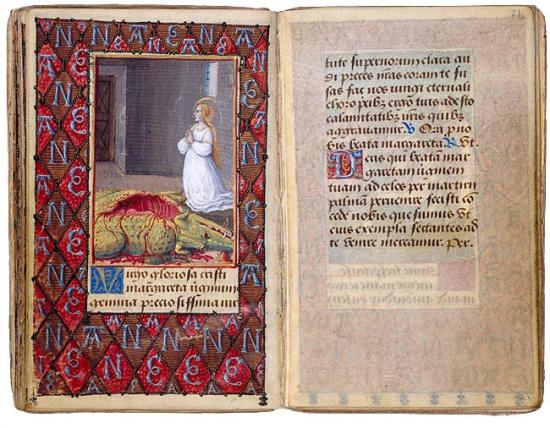
St. Margaret and the Dragon
Prayer Book of Anne de Bretagne
Illuminated by Jean Poyer
The Pierpont Morgan Library, Purchased in 1905
This prayer book was commissioned by Anne de Bretagne, wife of two successive kings of France, Charles VIII and Louis XII, to teach her son, the dauphin Charles-Orland (1492–1495), his catechism. It was painted in Tours by Jean Poyer, an artist documented as working for the queen. The book is richly illustrated, and its thirty-four airy, light-flooded miniatures are among the most delicate examples of late-fifteenth-century art.
St. Margaret and the Dragon (fol. 20v, left)
Margaret had caught the eye of the Roman prefect Olybrius, who wanted her as his wife or mistress. Rejecting him, Mar- garet was thrown into a prison where a devil, in the form of a dragon, swallowed her. The saint was miraculously delivered from the bloody belly of the monster.
St. Margaret, like Catherine and Ursula, belongs to a large group of early Christian martyrs that was popular in the late Middle Ages. The pride of place that these three women receive among the Suffrages in her prayer book is a reflection of the piety and patronage of Anne de Bretagne. Margaret, for example, was patron of safe childbirth, always a concern of the mother of a potential king.
Fol. 21v
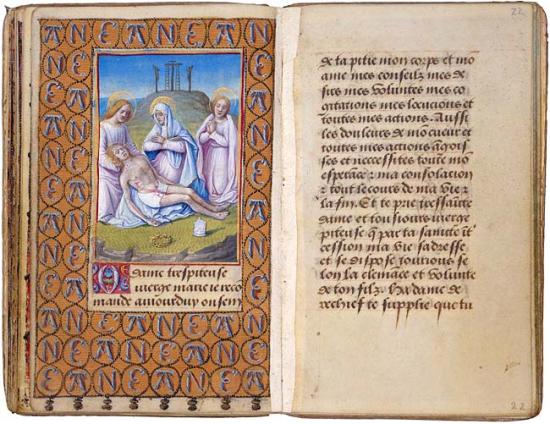
Lamentation
Prayer Book of Anne de Bretagne
Illuminated by Jean Poyer
The Pierpont Morgan Library, Purchased in 1905
This prayer book was commissioned by Anne de Bretagne, wife of two successive kings of France, Charles VIII and Louis XII, to teach her son, the dauphin Charles-Orland (1492–1495), his catechism. It was painted in Tours by Jean Poyer, an artist documented as working for the queen. The book is richly illustrated, and its thirty-four airy, light-flooded miniatures are among the most delicate examples of late-fifteenth-century art.
Lamentation (fol. 21v, left)
The dead Christ, removed from the empty cross in the background, lies in his pious mother's lap; the pair is flanked by John the Evangelist and Mary Magdalene.
Poyer's composition accentuates the Virgin's sorrow at her son's bloody death and emphasizes her role as intercessor between humans and God.
The prayer accompanying this miniature is this book's only text in the vernacular, French, and was composed particularly for Anne de Bretagne. In the prayer Anne addresses the Virgin in a personal way, seeking protection from those who might harm her and from those who might usurp her possessions.
Fol. 23v
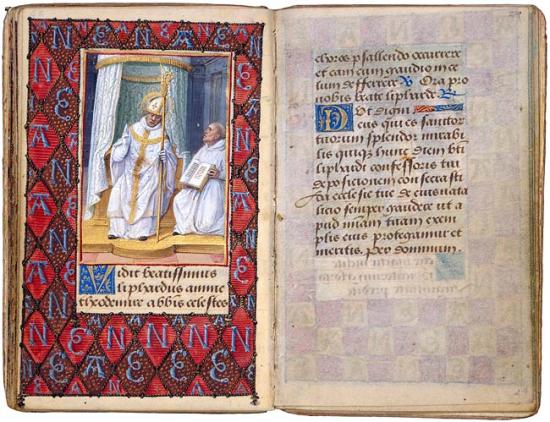
Sts. Liphard and Urbicius
Prayer Book of Anne de Bretagne
Illuminated by Jean Poyer
The Pierpont Morgan Library, Purchased in 1905
This prayer book was commissioned by Anne de Bretagne, wife of two successive kings of France, Charles VIII and Louis XII, to teach her son, the dauphin Charles-Orland (1492–1495), his catechism. It was painted in Tours by Jean Poyer, an artist documented as working for the queen. The book is richly illustrated, and its thirty-four airy, light-flooded miniatures are among the most delicate examples of late-fifteenth-century art.
Sts. Liphard and Urbicius (fol. 23v, left)
St. Liphard is identified as an abbot in chasuble (the ornate vestment worn by the priest at Mass) and miter (liturgical headdress) he wears as well as the crozier (symbolic staff) he is holding. He offers a blessing from a book held by a monk who is probably meant to be St. Urbicius.
Urbicius was the sole companion with whom Liphard had retired in solitude and who succeeded Liphard as head of the religious community that came into being around the two at Meung-sur-Loire.
Fol. 24v
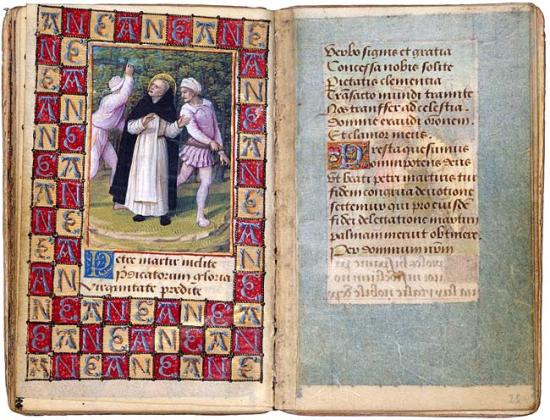
Slaying of St. Peter Martyr
Prayer Book of Anne de Bretagne
Illuminated by Jean Poyer
The Pierpont Morgan Library, Purchased in 1905
This prayer book was commissioned by Anne de Bretagne, wife of two successive kings of France, Charles VIII and Louis XII, to teach her son, the dauphin Charles-Orland (1492–1495), his catechism. It was painted in Tours by Jean Poyer, an artist documented as working for the queen. The book is richly illustrated, and its thirty-four airy, light-flooded miniatures are among the most delicate examples of late-fifteenth-century art.
Slaying of St. Peter Martyr (fol. 24v, left)
St. Peter of Verona's fame as a preacher and miracle worker was such that Pope Gregory IX appointed him inquisitor general for the Milanese territories. The saint, depicted here in the white habit and black cloak of the Dominican order, was assassinated on 6 April 1252 by killers hired by the heretical Cathari.
Peter was slain by a fatal blow to the head: His smashed skull is one of the prized relics housed by St. Eustorgio's in Milan.
Fol. 25v
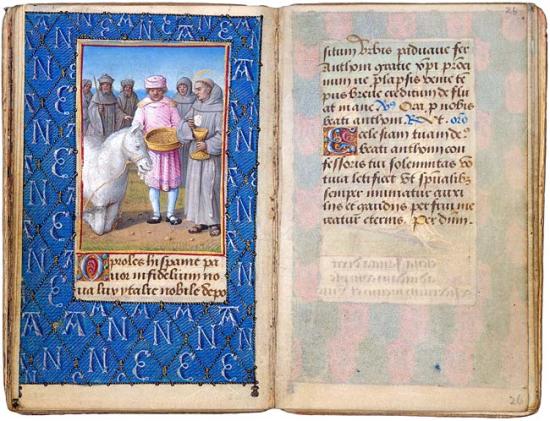
St. Anthony of Padua and the Miracle of the Mule
Prayer Book of Anne de Bretagne
Illuminated by Jean Poyer
The Pierpont Morgan Library, Purchased in 1905
This prayer book was commissioned by Anne de Bretagne, wife of two successive kings of France, Charles VIII and Louis XII, to teach her son, the dauphin Charles-Orland (1492–1495), his catechism. It was painted in Tours by Jean Poyer, an artist documented as working for the queen. The book is richly illustrated, and its thirty-four airy, light-flooded miniatures are among the most delicate examples of late-fifteenth-century art.
St. Anthony of Padua and the Miracle of the Mule (fol. 25v, left)
A mule ignores a basket of feed and piously genuflects and receives communion from St. Anthony (the "Miracle Worker of Padua"), a miracle that converted nonbelievers to accept the presence of Christ in the Eucharist.
Anthony wears the robe of the Franciscan order, tied at the waist with the rope that reappears throughout the manuscript's decorative borders—the cordelière—a personal device of Anne de Bretagne. Anthony was canonized less than a year after his death in 1231; his basilica in Padua remains a popular pilgrimage site to this day.
Fol. 26v
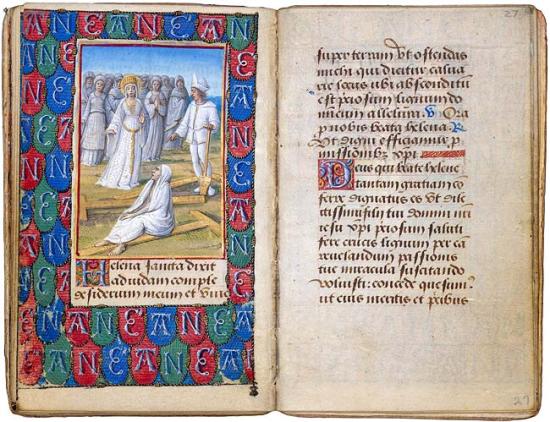
St. Helena Identifying the True Cross
Prayer Book of Anne de Bretagne
Illuminated by Jean Poyer
The Pierpont Morgan Library, Purchased in 1905
This prayer book was commissioned by Anne de Bretagne, wife of two successive kings of France, Charles VIII and Louis XII, to teach her son, the dauphin Charles-Orland (1492–1495), his catechism. It was painted in Tours by Jean Poyer, an artist documented as working for the queen. The book is richly illustrated, and its thirty-four airy, light-flooded miniatures are among the most delicate examples of late-fifteenth-century art.
St. Helena Identifying the True Cross (fol. 26v, left)
The great claim to fame for St. Helena, mother of Constantine (the first Christian emperor), was her discovery of the True Cross. Legend has it that she also found the crosses of the two thieves crucified along with Christ; she tested them all on a corpse and knew that the life- restoring cross must have been the Savior's.
After its discovery, the True Cross became one of Christianity's most sacred relics. The Library's Stavelot Triptych (on view in the Heinemann Gallery) is said to enshrine a piece of the True Cross.
Fol. 27v
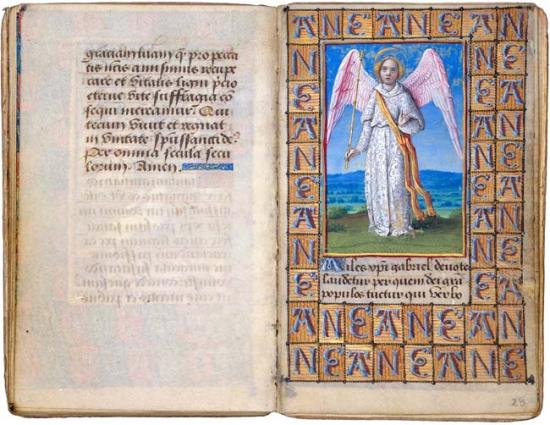
St. Gabriel the Archangel
Prayer Book of Anne de Bretagne
Illuminated by Jean Poyer
The Pierpont Morgan Library, Purchased in 1905
This prayer book was commissioned by Anne de Bretagne, wife of two successive kings of France, Charles VIII and Louis XII, to teach her son, the dauphin Charles-Orland (1492–1495), his catechism. It was painted in Tours by Jean Poyer, an artist documented as working for the queen. The book is richly illustrated, and its thirty-four airy, light-flooded miniatures are among the most delicate examples of late-fifteenth-century art.
St. Gabriel the Archangel (fol. 27v, left)
Poyer depicts St. Gabriel in a robe and gold sash holding a scepter topped with a fleur-de- lis, signifying the archangel as a special protector of the French.
The Suffrage to Gabriel emphasizes the archangel's role in mankind's salvation at the moment of the Incarnation and alludes to his role as weigher of souls at the Last Judgment.
Fol. 29
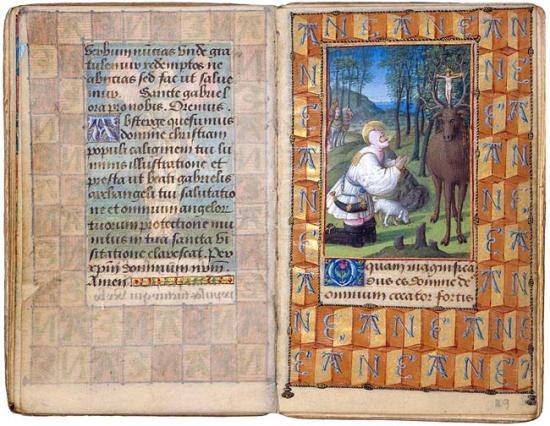
St. Hubert Worshiping the Miraculous Stag
Prayer Book of Anne de Bretagne
Illuminated by Jean Poyer
The Pierpont Morgan Library, Purchased in 1905
This prayer book was commissioned by Anne de Bretagne, wife of two successive kings of France, Charles VIII and Louis XII, to teach her son, the dauphin Charles-Orland (1492–1495), his catechism. It was painted in Tours by Jean Poyer, an artist documented as working for the queen. The book is richly illustrated, and its thirty-four airy, light-flooded miniatures are among the most delicate examples of late-fifteenth-century art.
St. Hubert Worshiping the Miraculous Stag (fol. 29, right)
Hubert, an eighth-century nobleman, went hunting on Good Friday instead of going to church and had an immediate conversion when a shining crucifix appeared between a stag's antlers.
The stag, an animal that continually sheds and grows its antlers, often appears in art as a symbol of creation and renewal, themes exemplified by Christ.
The lush forest setting and wide range of animals depicted in this miniature reveal Poyer's artistic mastery of the natural world.
St. Hubert's cult in the Middle Ages was based on the protection or cure he provided from rabies for both humans and dogs used in the chase.
Fol. 29v–30r
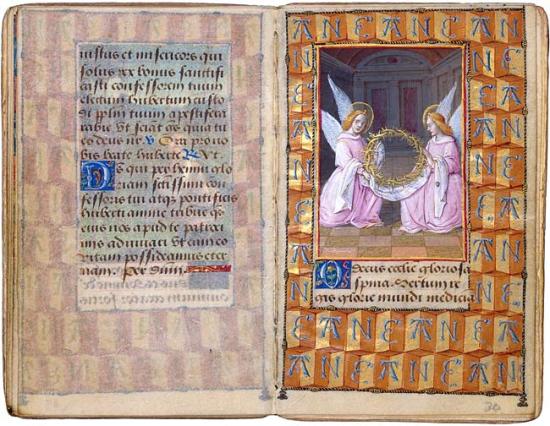
Angels Displaying the Crown of Thorns (fol. 30, right)
Prayer Book of Anne de Bretagne
Illuminated by Jean Poyer
The Pierpont Morgan Library, Purchased in 1905
This prayer book was commissioned by Anne de Bretagne, wife of two successive kings of France, Charles VIII and Louis XII, to teach her son, the dauphin Charles-Orland (1492–1495), his catechism. It was painted in Tours by Jean Poyer, an artist documented as working for the queen. The book is richly illustrated, and its thirty-four airy, light-flooded miniatures are among the most delicate examples of late-fifteenth-century art.
Poyer's penultimate image offers an immediate and intimate encounter with a powerful symbol of Christ's Passion.
Anne de Bretagne was particularly devoted to the Crown of Thorns. King Louis IX of France had acquired the Crown of Thorns in 1239; he built the Ste.-Chapelle as a suitable church in which to house it and other relics. Anne de Bretagne, as queen, had particular and private access to the chapelle and its precious contents.
Fol. 31
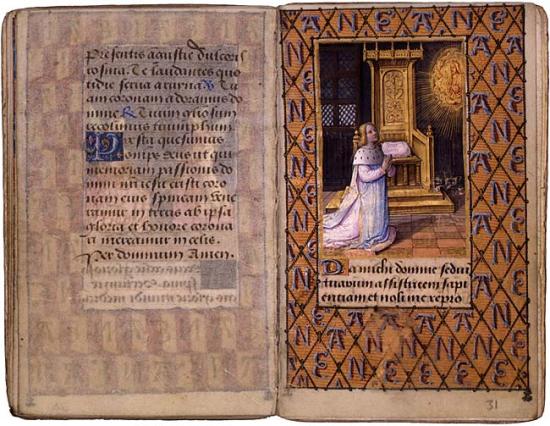
The Dauphin, Charles-Orland, at Prayer
The Pierpont Morgan Library, Purchased in 1905
This prayer book was commissioned by Anne de Bretagne, wife of two successive kings of France, Charles VIII and Louis XII, to teach her son, the dauphin Charles-Orland (1492–1495), his catechism. It was painted in Tours by Jean Poyer, an artist documented as working for the queen. The book is richly illustrated, and its thirty-four airy, light-flooded miniatures are among the most delicate examples of late-fifteenth-century art.
The Dauphin, Charles-Orland, at Prayer (fol. 31, right)
Poyer's final illumination for the Prayer Book of Anne de Bretagne depicts Charles-Orland, firstborn son of the queen and King Charles VIII, kneeling at prayer. The dauphin began his religious education on his mother's knee before his third birthday. Anne assumed the little prince would take some time learning all the book's prayers, for Charles-Orland is depicted at about the age of twelve.
Behind Charles-Orland is an empty throne, and it is for the wisdom with which to occupy this throne that the young prince prays.
The unfortunate prince Charles-Orland died just after his third birthday, so he never got to learn this prayer Anne had composed specially for him.
